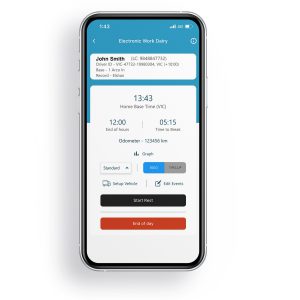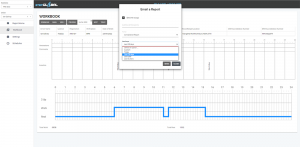Heavy vehicle log books are an important part of transport industry today. It is a legal requirement of the HVNL (heavy vehicle national legislation) for all heavy vehicle drivers to record their work and rest times using either a written work diary (WWD) or an electronic work diary (EWD). Therefore, every heavy vehicle driver in Australia will be using some form of log book to record their hours.
Many heavy vehicle drivers and businesses are still relying on paper log books to record their work and rest times, which can come with its own set of challenges. For instance, using a paper log book means that you must memorise and remember all of the NHVR fatigue plan rules, keeping your eye on the clock to ensure you don’t breach them. Fumbling around in your cab to try and find your written work diary can be a hassle, plus they can be easily lost or damaged. Not to mention the paperwork! Having to submit reports when using a paper log book generally results in a lot of double-handling for both the driver and the fleet manager.
That’s why many heavy vehicle drivers and businesses are turning towards electronic record keeping by switching to an EWD.
Some reasons why electronic log books are better than paper ones:
- They are designed for mobile devices, so they’re always with you
- EWDs are programmed with NHVR fatigue plan rules, so they’ll send you automatic rest break and breach notifications
- They count time down to the nearest minute, unlike paper log books which count in 15-minute blocks
- They make reporting simple and reduce double-handling of paperwork
Switching to an Electronic Heavy Vehicle Log Book
Although it may seem daunting, making the switch to an electronic work diary is very straightforward. Many drivers and managers who make the switch often say that they wish they’d done it sooner.
The great thing about EWDs is that they do all the thinking for you. When setting up the app, you can select from either Standard, Basic Fatigue Management (BFM) or Advanced Fatigue Management (AFM) hours, depending on which program you are currently operating under. For a full explanation of the NHVR’s fatigue plans, you can read more here. Once you’ve selected which plan to operate under, the app will now take over the hard stuff, and send you notifications when you’re close to needing to take a rest break, or if you’re about to be in breach.
This functionality brings real peace of mind to everyone involved, from the driver right through to the business owners, schedulers and managers. Everyone has a duty of care under the Chain of Responsibility (CoR), and EWDs reduce human error by automating fatigue rules and notifications.
When the driver wants to start driving, it’s as simple as tapping a button. Likewise, when they’re ready to take their break (which they’ll be automatically notified they are due for), the driver taps the start rest button. And once they’re ready to end their shift, it’s as simple as tapping the end of day button.
This way of recording heavy vehicle work and rest times is much more efficient than taking it all down manually, and can save up to 50% of driver reporting time.

Easy Compliance Reporting for Fleet Managers and Schedulers
The benefits don’t just end at automating fatigue plan rulesets. Many businesses find the implementation of an electronic work diary to be a total gamechanger when it comes to compliance reporting. Gone are the days of photocopies and piles of paperwork; with an EWD, fleet managers can access compliance reports at the click of a button. Not only that, but some EWDs offer automatic notifications to fleet managers for breach and potential non-compliance events.
If you’re a scheduler of heavy vehicle drivers, EWDS allow you to access information about the hours your drivers have available for the rest of the month. This brings a level of flexibility and forward-planning that otherwise would be hard to achieve with paper log books.

Choosing Which Heavy Vehicle Log Book to Use
At the end of the day, choosing an electronic work diary is about making things simpler and more efficient. While most EWDs will offer you this, there are some important factors to consider when making your final pick.
When considering which EWD to switch to, always ensure that it has been approved by the NHVR. There are some options on the market that claim to be based around NHVR logbooks and fatigue plans, but they have not gained certification, and therefore any data collected by them is invalid.
Smart eDriver was the very first EWD to gain NHVR certification in 2020, and it has stood the test of time. Not only is it simple to use, it’s also extremely flexible. It is cloud-based and can be downloaded from the Google Play Store or Apple App Store. Some other EWD options may require the use of telematics or connection to the vehicle, but Smart eDriver is a standalone app that can be used by anyone with a mobile device.
Whether you’re a fleet manager or a solo driver, Smart eDriver has got the functionality that you’ll need. For fleet managers and businesses, there is a powerful business analytics platform, and custom reports can be implemented for a small monthly charge. For solo drivers who drive for multiple businesses, Smart eDriver supports multiple business profiles, so you can always be on top of your compliance obligations.
Smart eDriver has one low monthly fee with no lock-in contracts, and offers a free 2-week trial to get started. You can contact the Smart eDriver team to find out more, or continue to do your own research about which EWD is best for you.
